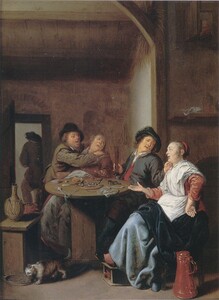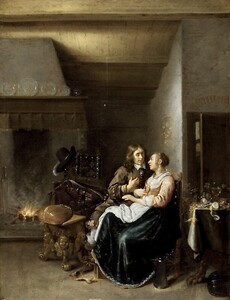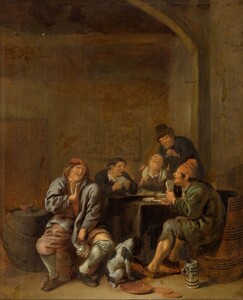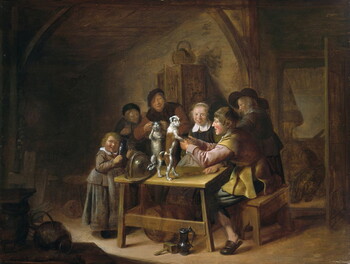4.700 €
A flirting couple
Oil on panel : 35,9 X 29,6 cm
Signed “molenaer” (barely legible) lower right, on the small stove which the woman’s left foot rests on
Frame : 46,4 X 40,4 cm
Our painting is recorded at the RKD, The Hague, number 343776 (May 2025, identification given by Ellis Dullaert): dating from the late 1640s or from the very start of the 1650s
In short
Jan Miense Molenaer was an excellent painter of the ordinary behaviour of the lower social classes in taverns. According to Dennis Paul Weller, writer of the catalogue of the first monographic exhibition of Molenaer (in 2002), in Raleigh, at the North Carolina Museum, our painter tried circa 1650 to reach out to richer clients, which he exceptionally represented in just a few works from that period. Our painting is an excellent example of this effort.
But what the modern viewer does no longer see, was easy to identify for 17th century spectators: this is actually a brothel scene, a warning against bad behaviour for the respectable Dutch Calvinists. Behind the rich, well-dressed man Molenaer has painted a lute, a then common erotic element: the Dutch word “luit” was a slang term for vagina. It identifies many merry companies as brothel scenes.
About Jan Miense Molenaer
Dutch painter
Haarlem 1609/10 – 1668 Haarlem
Jan Miense Molenaer specialised in genre scenes, but his oeuvre also extends into portraiture, history painting and scenes of contemporary theatre.
He was a pupil of Frans Hals, possibly also of his younger brother Dirk Hals.
He was active in Haarlem and in nearby Heemstede (1629-1636, 1648-1655, 1657-1668) and in Amsterdam (1637-1648, 1655-1656).
Molenaer seems to have had a pugnacious and generally unpleasant character: disputes over relatively insignificant matters and amounts became a second occupation. When he was not suing others for non- payments, his own property was being confiscated. Although he was constantly fighting over finances with his creditors the inventory of his possessions made after his death suggests he was rich.
In 1636 he married Judith Leyster (1609-1660), one of the most famous female painters of the 17th century. She sacrificed her successful career for family life. The couple had five children.
There is a marked difference between Molenaer’s early and late pictures, both in subject matter and in style.
The early works, dating between 1629 and 1640, are considered to belong to his best creative period, when he produced colourful paintings full of inventive symbolism, wit and humour, influenced by Frans Hals.
After 1640 Molenaer turned to tonal colours, mostly depicting the behaviour of peasants, the ordinary life of the underclass. This change followed his move from Haarlem, where his financial situation had been desperate, to the booming metropolis of Amsterdam in 1637. In the highly specialised art market of those days Molenaer tried to become the low-life specialist of Amsterdam, aiming to get a position comparable to that of Adriaen and Isaac van Ostade in his native Haarlem. Such a genre scenes with happy merrymakers were both a source of delight and of instruction for the town population of the young, Protestant Dutch Republic.
Molenaer’s move in 1648 from Amsterdam to a heavily mortgaged house in the village of Heemstede, south of Haarlem, divides this second period of creation in two. While his Amsterdam years had been years of hope, of a new direction in his artistic development, the paintings from his later career, after 1649, hold fewer originality and contain often recycled popular motifs of interior scenes. Still in these last two decades of his life his production was unexpectedly large and the quality remained high.
Molenaer should be seen as an active participant in the Brueghel revival that occurred in the second quarter of the 17th century. He continued the Haarlem tradition of peasant scenes founded by Adriaen Brouwer and Adriaen van Ostade, leading to his younger contemporary Jan Steen.
About the subject of our painting : a brothel scene
Brothel scenes (“Bordeeltjes”) were a popular theme in 17th century Dutch genre painting. One may wonder how this was possible in a largely Protestant society that criminalized prostitution, procuring and adultery.
Just like tavern interiors, representations of unequal love (between a rich old man and a young woman) and Vanitas still lifes (about the vanity of earthly goods) these paintings must have served as a warning against bad behaviour for the respectable Calvinists.
These bordello scenes vary from rather explicit representations of cheerful companies with half naked courtesans to rather elegant parties which, for contemporary viewers, were as easily recognizable as the others. Today they are often called “merry companies”…
While the Catholic Church had regarded prostitution as a necessary evil, made sadly unavoidable by the sinful state of humanity, in the new Protestant societies it was prohibited. Whenever a city was taken over by the Calvinists during the course of the Dutch Revolt in the late 16th and first half of the 17th century, one of the first acts of the new city government was to close down the municipal brothels and to suppress prostitution.
But this prohibition was impossible to maintain in a society that possessed too many characteristics favouring widespread prostitution, especially in its main town Amsterdam, where each year thousands of sailors ended their journeys and were paid off, following long journeys without women.
Prostitution was condemned from the pulpit and regulated through fines, jail terms, flogging or banishment. But still it flourished, not in large bordellos (as you would find them in Catholic towns), but in hundreds of small houses.
Seventeenth century prostitution in Holland was mainly in the hands of women: a bawd (“hoerewaardin”) usually ran a very small whorehouse with one, two, maximum three harlots. If there were more clients a maid would fetch more whores in the neighbourhood. In paintings these bawds are generally represented as ugly, often hideously grinning, old procuresses (“koppelaarster”). The books of confessions from the prisoners learn us that most bawds were not that much older than their whores. Representing them as old women, as the embodiment of vices and evil, seems to go back to the persecution of witches.
It is funny how, since the Victorian age, these representations of bordellos have been called ‘merry companies’ for there was a lute lying on a table, hanging on the wall or a lady was playing the instrument. No, 17th century prostitutes were not musically highly talented. In Dutch a lute was slang for a vagina, so any 17th century viewer could immediately identify the profession of these ladies.
Why should you buy this painting?
Because you have here an interesting conversation piece: there is clearly more to this innocent flirting scene … .
Comparative paintings
Click photos for more details




